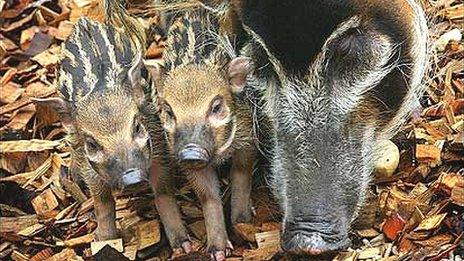How do zoos prepare for dangerous animal escapes?
- Published
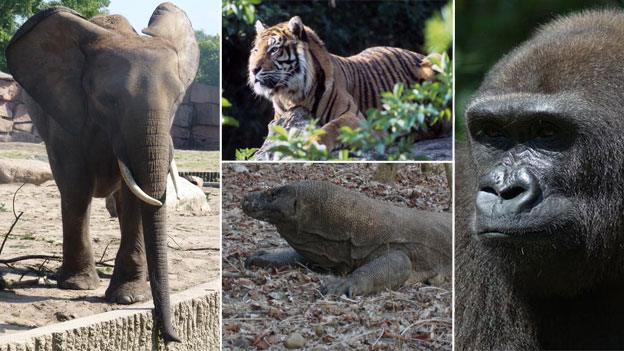
The animals zoos most fear being on the loose include elephants, big cats and a komodo dragon
As the Easter Bank Holiday gets under way, many people may be contemplating a trip to their local zoo. This is generally accepted as a safe, family-friendly activity but in fact, escapes by wild animals are not unheard of.
Imagine the scenario. Unpredictable carnivores break through the steel wire of a zoo enclosure and are on the loose. It is every zookeeper's nightmare.
Yet for keepers at Colchester Zoo six months ago, that fear became a reality when five wolves managed to escape.
Somehow they had broken through a special steel mesh fence - a fence the zoo says was checked on a daily basis. Three wolves were shot dead and two were tranquilised. To the zoo's relief, though, no members of the public were harmed.
Industry experts say the zoo's handling of the incident, from an operational perspective, was successful and the rarity of such escapes highlights the great lengths zoos go to to keep the public safe.
So how do zoos manage to keep visitors - and animals - safe?
Step one: Designing a zoo
Preventing animal escapes starts with bricks and mortar.
Strong, high walls usually come as standard and there will usually be an inner and an outer perimeter.
Rock solid on the outside, zoos must also support free movement within - for emergency vehicles such as fire engines, trucks carrying large animals and, of course, visitors.
Many zoo buildings - such as restaurants, shelters and visitor centres - share a double purpose; they are sealable safety refuges in case of emergency.
Equally important is designing enclosures with adequate space for the animals and using tough materials - such as toughened safety glass and stainless steel zoo mesh.
Inside enclosures are areas that animals can be taken to for safety. This is especially important when they are about to be moved, because that is one of the times when an escape is most likely.
Dr Kirsten Pullen, chief executive of the British and Irish Association of Zoos and Aquariums (BIAZA) said: "Some of our zoos are well over 100 years old when health and safety concerns were less of a concern than they are now. These zoos have had to adapt."
Step two: Knowing the risks
An in-depth knowledge of the types of animals housed is essential.
Each species is different, as are the risks they pose.
Zoos rank animals according to the amount of damage they could cause if they escaped. Wolves, for example, are classified as category one on a three-level scale.
Joining them in category one are the big cats, elephants, rhinos, great apes and the world's largest lizard, the komodo dragon.
Zoo staff also need to be aware of the "danger points" during the daily routine, when zoo security is at its most vulnerable.
So, thorough procedures will be in place for feeding times, moving animals, veterinary visits, maintenance work and so on.
This, combined with a daily series of enclosure checks, are how zoos manage to make sure escapes are an "unusual occurrence", said Dr Pullen.
Step three: Practice, practice, practice
Zoos which are home to dangerous animals are subject to stringent legal requirements to protect the public.
Drills are carried out at least twice a year for a dangerous animal escape.
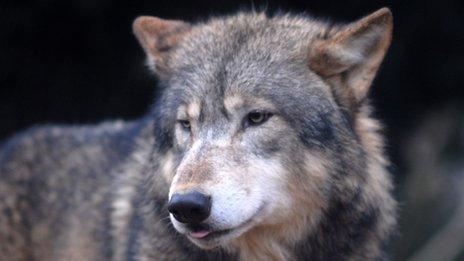
Experts say the use of lethal force by Colchester Zoo was the right thing to do once the animals had escaped the confines of the zoo complex
These are usually desktop exercises, to make sure each member of staff knows his or her role in advance.
"Our keepers are there because they have a passion for the animals," says Dr Pullen.
"It is a situation that none of us want to have to face but we do have to prepare for it."
The way a zoo responds to an animal escape depends on the type of animal missing and where it escapes to.
In the case of the wolf escape, for example, the zoo had to inform the police as soon as the zoo premises were breached.
If it just escapes its enclosure into the zoo's grounds, the police do not have to be told.
A spokeswoman for the RSPCA said: "We think zoos should do everything possible to prevent escape in the first place because once dangerous animals have escaped there will always be the risk that they will need to be killed for safety reasons, however hard that decision is."
Step four: Public, public, public
Human life is always the "first priority" for zoos, says Dr Pullen.
She said once a dangerous animal escapes from the zoo and is in a public space, the most likely outcome is it will be shot.
Not only are dangerous animals unpredictable "outside their own environment", but the people who might encounter them can be too.
The unpredictability of the human reaction will also define what visitors are told when an animal is on the run.
"Each zoo will make a call about how much information they release to the public, because they don't want panic," says Dr Pullen.
In the Colchester case, while one wolf remained at large for most the day, the upper part of the zoo remained open to the public.
This was only possible because of the way the zoo was designed, which allowed for the lower part to be sealed off.
Spotters, the zoo said at the time, were stationed around the perimeter during the escape to ensure public safety.
But for hours, customers visiting the zoo were blissfully unaware a wolf was on the loose.
And when - at about 15:30 - it came to telling customers the zoo was closing a little early - they were told not of an an animal escape but of "a medical emergency".
Bryony Williams, who was at the zoo at the time with her children, said she was concerned she was not told of the escaped wolves.
She said she understood alerting the public might have caused "hysteria" but she had mixed feelings about the way it was handled.
She said describing the situation as a "medical emergency" seemed "a bit silly".
But Dr Pullen said the decision about what to tell the public would have been made in the best interests of those in the zoo at the time.
Step five: Lethal force?
The Colchester wolf escape was brought to an end with the pull of a marksman's finger.
A day later, Essex Police was criticised via social media by people who wrongly assumed it was police marksmen who shot the wolves.
As the police were keen to point out , via Twitter, it was the zoo's own staff who shot the animal.
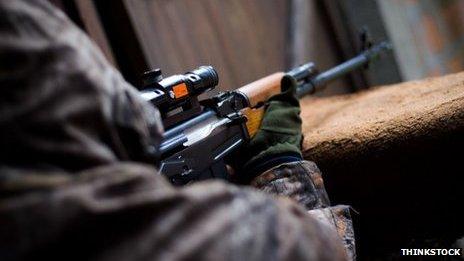
Zoos need to have both properly trained marksmen on hand and the right calibre weapons available
"All of our zoos with dangerous animals have a requirement to hold firearms licenses and their staff have regular firearm training," said Dr Pullen.
Zoos also have to ensure they have the right calibre of gun depending on the types of animals they have. A far larger calibre of rifle is needed to kill an elephant, for example, than a wolf.
Dr Pullen said despite criticism made about the zoo's decision to shoot dead three of their wolves, they did exactly the "right thing".
She said once a dangerous animal escapes from the zoo and is in a public space the most likely outcome is it will be shot.
- Published28 November 2013
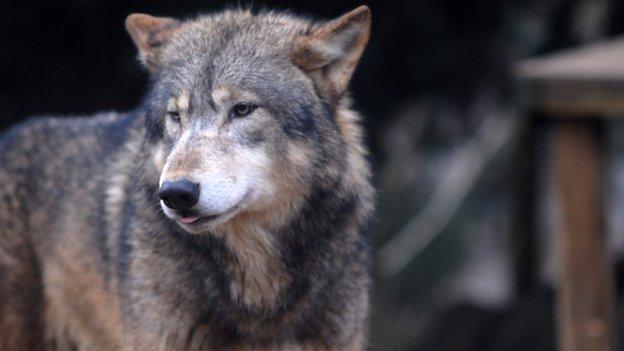
- Published7 August 2013
